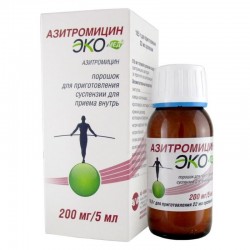




Security policy (edit with Customer reassurance module)

Delivery policy (edit with Customer reassurance module)

Return policy (edit with Customer reassurance module)
Composition, form of release and packaging
Suspension - 5 ml.:
Active ingredient: azithromycin dihydrate (in terms of azithromycin - 200.00 mg) - 209.64 mg;
Excipients: lactitol - 400.00 mg; sodium carbonate anhydrous - 83.00 mg; crospovidone (kollidon CL-M) - 65.00 mg; strawberry flavor - 55.00 mg; sodium benzoate - 16.50 mg; xanthan gum - 15.00 mg; apple flavor - 13.75 mg; cinnamon flavor - 13.75 mg; titanium dioxide - 10.00 mg; colloidal silicon dioxide - 5.50 mg; mint flavor - 0.50 mg; sucrose to weight - 3.75 g.
16.5 g in dark glass bottles with a capacity of 60 ml with a plastic screw cap with a sealing insert made of silica gel.
1 bottle, together with a dosing syringe and instructions for use, is placed in a cardboard box.
Description of the dosage form
Capsule-shaped, biconvex, yellow film-coated tablets. Two layers are visible in cross section, the inner layer is white or almost white.
Pharmacotherapeutic group
The antibiotic is azalide.
Pharmacokinetics
After oral administration, azithromycin is well absorbed and rapidly distributed in the body. Bioavailability after a single dose of 0.5 g - 37% (the effect of the "first pass" through the liver), the maximum concentration (Cmax) after oral administration of 0.5 g - 0.4 mg / l, the time to reach the maximum concentration (TCmax) - 2 -3 h. Concentration in tissues and cells is 10-50 times higher than in serum. The volume of distribution is 31.1 l / kg, plasma protein binding is inversely proportional to the concentration in the blood and is 7-50%. Azithromycin is acid-resistant, lipophilic. Easily passes through histohematic barriers, penetrates well into the respiratory tract, internal organs and tissues, including the prostate gland, skin and soft tissues. It is also transported to the site of infection by phagocytes, polymorphonuclear leukocytes and macrophages, where it is released in the presence of bacteria. Penetrates through cell membranes and creates high concentrations in them, which is especially important for the eradication of intracellular pathogens.
In the foci of infection, the concentration is 24-34% higher than in healthy tissues and correlates with the severity of the inflammatory process. Remains in effective concentrations for 5-7 days after the last dose.
Demethylated in the liver, the resulting metabolites are not active. The isoenzymes CYP3A4, CYP3A5, CYP3A7, which it is an inhibitor of, are involved in the metabolism of the drug. Plasma clearance - 630 ml / min: half-life between 8 and 24 hours after administration - 14-20 hours, half-life in the range from 24 to 72 hours - 41 hours. More than 50% of the drug is excreted through the intestines unchanged, 6% - kidneys.
Food intake significantly changes the pharmacokinetics: Cmax increases (by 31%), the area under the concentration-time curve (AUC) does not change.
In older men (65-85 years old), pharmacokinetic parameters do not change, in women Cmax increases (by 30-50%).
Pharmacodynamics
A broad-spectrum antibacterial drug from the group of macrolides-azalides, has a bacteriostatic effect. By binding to the 50S subunit of ribosomes, it inhibits the peptide translocase at the translation stage, inhibits protein synthesis, slows down the growth and reproduction of bacteria, and in high concentrations has a bactericidal effect. It acts on extra- and intracellularly located pathogens.
Microorganisms may be inherently resistant to the antibiotic or may become resistant to it.
Scale of sensitivity of microorganisms to azithromycin (Minimum inhibitory concentration, mg/l):
Microorganism Staphylococcus - MIC Susceptible ≤ 1 mg/l; Persistent > 2 mg/l;
Microorganism Streptococcus A, B, C, G - MIC Susceptible ≤ 0.25; Persistent > 0.5 mg/l;
Microorganism Streptococcus pneumoniae - MIC Susceptible ≤ 0.25; Persistent > 0.5 mg/l;
Microorganism Haemophilus influenzae - MIC Susceptible ≤ 0.12; Persistent > 4 mg/l;
Microorganism Moraxella catarrhalis - MIC Susceptible ≤ 0.5; Persistent > 0.5 mg/l;
Organism Neisseria gonorrhoeae - MIC Susceptible ≤ 0.25; Persistent > 0.5 mg/l.
sensitive
Aerobic gram-positive microorganisms: Staphylococcus aureus (methicillin-sensitive), Streptococcus pneumoniae (penicillin-sensitive), Streptococcus pyogenes.
Aerobic gram-negative microorganisms: Haemophilus influenzae, Haemophilus parainfluenzae, Legionella pneumophila, Moraxella catarrhalis, Pasteurella multocida, Neisseria gonorrhoeae.
Anaerobic microorganisms: Clostridium perfringens, Fusobacterium spp., Prevotella spp., Porphyromonas spp..
Others: Chlamydia trachomatis, Chlamydia pneumoniae, Chlamydia psittaci, Mycoplasma pneumoniae, Mycoplasma hominis, Borrelia burgdorferi.
Moderately sensitive or insensitive
Aerobic gram-positive microorganisms: Streptococcus pneumoniae (moderately sensitive or resistant to penicillin).
Resistant
Aerobic gram-positive microorganisms: Enterococcus faecalis, Methicillin-resistant strains of Staphylococcus aureus.
Anaerobes: Bacteroides fragilis group; Streptococcus pneumoniae, beta-hemolytic Streptococcus spp. groups A, Enterococcus faecalis and Staphylococcus aureus (including methicillin-sensitive strains), resistant to erythromycin and other macrolides, lincosamides, are also resistant to azithromycin.
Indications for use
Infectious and inflammatory diseases caused by microorganisms sensitive to azithromycin:
infections of the upper respiratory tract and ENT organs: pharyngitis, tonsillitis, sinusitis, otitis media;
lower respiratory tract infections: acute bronchitis, exacerbation of chronic bronchitis, pneumonia, incl. caused by atypical pathogens;
skin and soft tissue infections: erysipelas, impetigo, secondarily infected dermatoses;
the initial stage of Lyme disease (borreliosis) - migrating erythema (erythema migrans) /
Contraindications for use
Hypersensitivity to azithromycin (including other macrolides) or other components of the drug;
severe renal failure (creatinine clearance (CC) less than 40 ml / min);
severe liver failure (Child-Pugh class C);
breast-feeding;
simultaneous reception with ergotamine and dihydroergotamine;
children's age up to 6 months;
sucrase / isomaltase deficiency, fructose intolerance, glucose-galactose malabsorption;
hypersensitivity to erythromycin; ketolides.
With caution: pregnancy, myasthenia gravis, mild to moderate liver dysfunction, mild to moderate renal dysfunction (creatinine clearance more than 40 ml / min), diabetes mellitus, in patients with proarrhythmic factors (especially in elderly patients): with congenital or acquired prolongation of the QT interval, in patients receiving therapy with antiarrhythmic drugs of classes IA (quinidine, procainamide), III (dofetilide, amiodarone and sotalol), cisapride, terfenadine, antipsychotics (pimozide), antidepressants (citalopram), fluoroquinolones (moxifloxacin and levofloxacin), with impaired fluid and electrolyte balance, especially in the case of hypokalemia or hypomagnesemia, with clinically significant bradycardia, cardiac arrhythmia or severe heart failure; simultaneous use of digoxin, warfarin, cyclosporine.